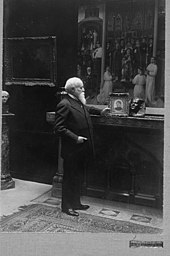Friedrich Ludwig von Gans
Friedrich Ludwig (Fritz) Gans , from 1912 von Gans (born November 15, 1833 in Frankfurt am Main , † July 15, 1920 in Bad Homburg vor der Höhe ) was a major German industrialist, patron and art collector.
family
Gans came from one of the oldest German Jewish families with a permanent family name, which has been mentioned since 1350. His father, Ludwig Aaron Gans , son of Philipp Ahron Gans and Fanny Hanau, came from the Jewish trading family that had lived in Celle for over 150 years and moved to Frankfurt. Fritz was one of the six children of Ludwig Aaron Gans (1794–1871) and his wife Rosette Goldschmidt (1805–1868). His brothers were Adolf and Leo Gans . His sisters were Henriette Heidelbach, Pauline Weinberg and Marianne Löwengard.
In 1862 he married Auguste Ettling (1839–1909), daughter of a wealthy businessman from Karlsruhe. The couple had three children: the daughter Adele, called Fanny (1863-1932) and the sons Paul (1866-1915) and Ludwig Wilhelm (1869-1946).
life and work
In 1847, the year Leopold Cassella died , Friedrich Ludwig Gans began working in his father's trading company Leopold Cassella & Comp. in Frankfurt am Main as an apprentice and later became its commercial director.
His brother Leo Gans founded the "Frankfurter aniline paint factory of Gans and Leonhardt" together with their brother-in-law Bernhard Weinberg and the chemist August Leonhardt at the Mainkur in Fechenheim in 1870 . In 1879, Friedrich Ludwig Gans brought a sum of 5 million gold marks from the legacy of his brother-in-law David Wilhelm (Spanish: Guillermo) Ettling, who had managed the Spanish Rothschild branch in Madrid, into the Fechenheim factory, thus laying the foundation stone for the boom in the factory, which flourished from then on. After August Leonhardt left the company in the same year, the company was renamed “Frankfurter Anilinfarbenfabrik Gans & Co” and Meinrad Hoffmann was brought into this production company. The company owed its rise to the world's largest azo paint factory around 1900 to his efforts. In 1894, Friedrich Ludwig Gans and his partners decided to merge the above-mentioned Frankfurt paint wholesaler Cassella with the "Frankfurter aniline paint factory Gans & Co" in Fechenheim. "Leopold Cassella & Co" was chosen as its new name. As one of the IG successor companies, “ Cassella Farbwerke Mainkur AG” was founded in 1952 .

In 1885 , Gans converted to Protestantism . He was a royal Prussian Real Privy Councilor entitled "Excellency" as well as a member of the Frankfurt Chamber of Commerce and supported numerous social institutions. After leaving the company, he mainly devoted himself to building up his art collections. In 1912 he donated his antique collection to the antique collection of the Royal Museums in Berlin . In return, the Prussian King Wilhelm II raised him to the Prussian nobility on March 11, 1912 with a diploma from November 4, 1912. In 1917 he gave the Städel two paintings, a Bismarck portrait by Franz von Lenbach and an old Frankfurt cityscape by Anton Burger . After Gans' death in 1920, his heirs sold the majority of his private collection to the art dealer Kurt Walter Bachstitz . Robert Zahn created the catalog .
Gans was buried in the mausoleum he built in 1909 , the largest tomb in Frankfurt's main cemetery .
Social foundations
- 1901: Böttgerstrasse children's home
- 1909: Fritz and Auguste Gans Foundation for the benefit of nurses in need of rest
- 1910: Gans' foundation for the police: for middle and lower civil servants who got into economic distress through no fault of their own, incorporated in the general alms box in 1951 .
literature
- Angela von Gans, Monika Groening: Die Familie Gans 1350-1963 , Verlag Regionalkultur, Heidelberg 2006, ISBN 978-3-89735-486-9 , pp. 145–205.
- Yearbook of the Roman-Germanic Central Museum Mainz , 1995, page 609 ( excerpt )
- Wolfgang Klötzer (Hrsg.): Frankfurter Biographie . Personal history lexicon . First volume. A – L (= publications of the Frankfurt Historical Commission . Volume XIX , no. 1 ). Waldemar Kramer, Frankfurt am Main 1994, ISBN 3-7829-0444-3 .
- Alexander Hoffmann: In change. 125 years of Cassella. 1870-1995. Published by Cassella AG Frankfurt. Frankfurt / M. Cassella (1995)
Web links
- Goose, Friedrich Ludwig von. Hessian biography. In: Landesgeschichtliches Informationssystem Hessen (LAGIS). Hessian State Office for Historical Cultural Studies (HLGL), accessed on March 18, 2014 .
- Jewish nursing history: biography
Individual evidence
- ^ Secret State Archives of Prussian Cultural Heritage, Berlin, I.HA Rep. 176 Heroldsamt, VI G 510.
- ^ Genealogisches Handbuch des Adels , Adelslexikon Volume IV, page 31, Volume 67 of the complete series, CA Starke Verlag, Limburg (Lahn) 1978.
- ↑ for example: Ganymede jewelry. Metropolitan Museum of Art , accessed July 4, 2016 .
| personal data | |
|---|---|
| SURNAME | Goose, Friedrich Ludwig von |
| ALTERNATIVE NAMES | Gans, Friedrich von; Goose, Fritz |
| BRIEF DESCRIPTION | German industrialist, patron, art collector |
| DATE OF BIRTH | November 15, 1833 |
| PLACE OF BIRTH | Frankfurt am Main |
| DATE OF DEATH | July 15, 1920 |
| Place of death | Bad Homburg vor der Höhe |

